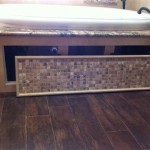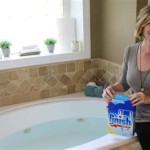Can You Use Finger Paint In The Bathtub? A Comprehensive Guide
The question of whether finger paint can be safely and effectively used in the bathtub is a common one for parents and caregivers looking to add a creative and engaging element to bath time. While the notion of transforming the bathroom into a canvas for artistic expression is appealing, careful consideration must be given to the potential risks and benefits involved. Several factors, including the type of finger paint, the bathtub surface, the child's age and sensitivities, and proper cleaning procedures, all play crucial roles in determining the viability and safety of this activity.
The primary concern when considering using finger paint in the bathtub revolves around the composition of the paint itself. Traditional finger paints often contain pigments, binders, preservatives, and other additives that may not be ideal for prolonged exposure to skin or for introduction into the plumbing system. Some ingredients could potentially cause skin irritation, allergic reactions, or even staining of the bathtub surface. Therefore, a thorough understanding of the paint's ingredients and its intended use is paramount before allowing children to use it in the bath.
Furthermore, the type of bathtub material is a key determinant in how well it will withstand potential staining or damage from finger paint. Porous surfaces like grout and certain types of natural stone are more susceptible to absorbing pigments than non-porous surfaces like acrylic or porcelain. Scratches or imperfections in the bathtub's finish can also provide entry points for pigments to become embedded, making them difficult to remove. Evaluating the bathtub's material and its condition is a necessary step in assessing the risks associated with using finger paint.
Understanding the Composition of Finger Paint
A detailed examination of the ingredients list of any finger paint product is crucial for determining its suitability for use in the bathtub. Many commercially available finger paints are marketed as non-toxic, which typically means they meet safety standards for ingestion in small quantities. However, non-toxic does not necessarily equate to being entirely harmless or stain-resistant. Some pigments, even those considered non-toxic, can still cause irritation to sensitive skin or leave behind visible stains on porous surfaces. Binders, which are used to give the paint its texture and consistency, can sometimes create residue that is difficult to remove from the bathtub.
When evaluating finger paint composition, it is beneficial to look for products specifically designed for use on skin or that are labeled as washable and easily removable. Water-based finger paints are generally a better choice than oil-based paints, as they tend to be easier to clean up and less likely to leave behind greasy residues. It is also wise to avoid paints that contain heavy metals, strong dyes, or fragrances, as these can increase the risk of allergic reactions or skin irritation. Consider options made with natural food-based ingredients, as these are often safer and easier to wash away. However, even natural ingredients can cause allergic reactions in sensitive individuals, so caution is still warranted.
Parents can also consider making homemade finger paint using common household ingredients such as cornstarch, water, and food coloring. Homemade finger paint offers greater control over the ingredients and can be customized to minimize potential risks. However, even homemade finger paint should be tested in a small, inconspicuous area of the bathtub before allowing children to use it extensively. Monitoring the child for any signs of skin irritation during and after use is also essential.
Assessing the Bathtub Surface and Potential for Staining
The type of material used in the construction of the bathtub has a significant impact on its susceptibility to staining from finger paint. Acrylic bathtubs are generally considered to be more resistant to staining than porcelain bathtubs, though the quality of the acrylic can vary. Porcelain bathtubs, especially older ones, may have a more porous surface that is more prone to absorbing pigments. Bathtubs made from natural stone, such as marble or granite, are particularly vulnerable to staining and should generally be avoided when using finger paint.
The condition of the bathtub's surface also plays a crucial role in determining its resistance to staining. Scratches, cracks, or chips in the finish can provide entry points for pigments to penetrate the surface, making them much more difficult to remove. Before using finger paint in the bathtub, it is advisable to inspect the surface for any imperfections that could potentially trap pigments. If the bathtub has any areas of damage, it may be best to avoid using finger paint altogether or to protect those areas with a temporary barrier.
A practical approach to assessing the potential for staining is to conduct a small-scale test in an inconspicuous area of the bathtub. Apply a small amount of the finger paint to the surface and allow it to sit for a short period of time, mimicking the duration of a typical bath time. Then, attempt to remove the paint using warm water and a mild soap. If the paint comes off easily without leaving any visible residue, it is likely safe to use the paint in the bathtub. However, if the paint leaves behind a stain or requires significant scrubbing to remove, it is best to avoid using that particular paint product.
Implementing Safety Measures and Cleaning Procedures
Even with careful consideration of the finger paint's composition and the bathtub surface, implementing appropriate safety measures and establishing effective cleaning procedures are essential for minimizing risks. Supervision of children during bath time is always paramount, especially when using finger paint. This ensures that children do not ingest the paint, rub it into their eyes, or engage in any behavior that could be harmful.
Before allowing children to use finger paint in the bathtub, it is also wise to apply a thin layer of petroleum jelly or a similar protective barrier cream to their skin, especially on areas that are more sensitive or prone to irritation. This can help to prevent direct contact between the paint and the skin, reducing the risk of allergic reactions or dryness. It is also advisable to keep bath time relatively short to minimize prolonged exposure to the paint.
Immediately after bath time, thorough cleaning of the bathtub is crucial to prevent staining and ensure hygiene. Rinse the bathtub thoroughly with warm water to remove any loose paint residue. Then, use a mild soap or bathtub cleaner to scrub the surface, paying particular attention to areas that may have come into contact with the paint. For stubborn stains, a paste made from baking soda and water can be applied to the affected area and allowed to sit for a few minutes before scrubbing. Avoid using abrasive cleaners or scouring pads, as these can damage the bathtub's surface. Finally, rinse the bathtub thoroughly with clean water and dry it with a soft cloth.
In situations where staining does occur, several cleaning techniques can be employed to attempt to remove the pigments. A solution of diluted bleach can be effective for removing stains from white or light-colored bathtubs, but it should be used with caution and in a well-ventilated area. Test the bleach solution in an inconspicuous area first to ensure that it does not damage the bathtub's finish. Other stain removal options include using a magic eraser, a paste of vinegar and baking soda, or commercially available stain removers specifically designed for bathtubs.
In conclusion, while the use of finger paint in the bathtub can provide a fun and creative outlet for children, it requires careful planning and execution to ensure safety and minimize the risk of staining or damage. By carefully evaluating the finger paint's composition, assessing the bathtub surface, implementing appropriate safety measures, and establishing effective cleaning procedures, parents can make informed decisions about whether to incorporate this activity into their children's bath time routine.

Crayola Bath Paints Tub Finger Paint Soap

Splish Splash I Was Painting A Bath Review Of Crayola Fingerpaint Soap For The Most Fun Time Ever Mama Writes Reviews

Crayola Bathtub Fingerpaint Soap Warning Snopes Com

Making Bath Time Quality With Kids Paint More

Crayola Bathtub Fingerpaint Our Point Of View

Bathtime Activities For Kids With Crayola Showit Blog

Bathtub Finger Paint Soap By Crayola Bath Tiktok

Crayola Neon Bathtub Finger Paint Soap

Tub Works Bathtub Finger Paint Soap 12 Pack Non Toxic Washable Bath For Toddlers And Kids

Bath Paints And Summer Days Off








